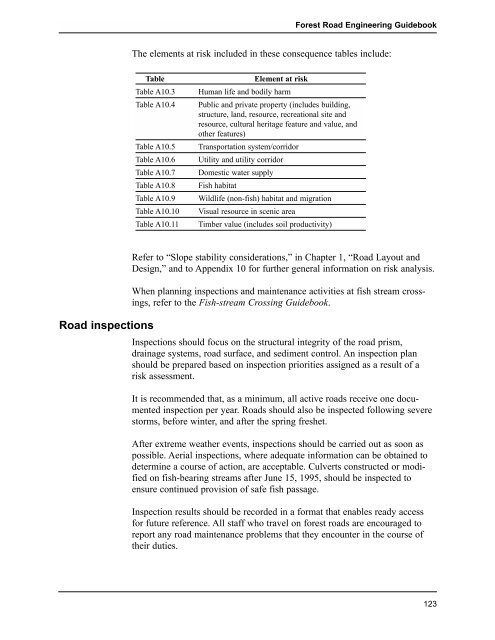Forest Road Engineering Guidebook - Ministry of Forests
Forest Road Engineering Guidebook - Ministry of Forests
Forest Road Engineering Guidebook - Ministry of Forests
Create successful ePaper yourself
Turn your PDF publications into a flip-book with our unique Google optimized e-Paper software.
<strong>Road</strong> inspections<br />
<strong>Forest</strong> <strong>Road</strong> <strong>Engineering</strong> <strong>Guidebook</strong><br />
The elements at risk included in these consequence tables include:<br />
Table Element at risk<br />
Table A10.3 Human life and bodily harm<br />
Table A10.4 Public and private property (includes building,<br />
structure, land, resource, recreational site and<br />
resource, cultural heritage feature and value, and<br />
other features)<br />
Table A10.5 Transportation system/corridor<br />
Table A10.6 Utility and utility corridor<br />
Table A10.7 Domestic water supply<br />
Table A10.8 Fish habitat<br />
Table A10.9 Wildlife (non-fish) habitat and migration<br />
Table A10.10 Visual resource in scenic area<br />
Table A10.11 Timber value (includes soil productivity)<br />
Refer to “Slope stability considerations,” in Chapter 1, “<strong>Road</strong> Layout and<br />
Design,” and to Appendix 10 for further general information on risk analysis.<br />
When planning inspections and maintenance activities at fish stream crossings,<br />
refer to the Fish-stream Crossing <strong>Guidebook</strong>.<br />
Inspections should focus on the structural integrity <strong>of</strong> the road prism,<br />
drainage systems, road surface, and sediment control. An inspection plan<br />
should be prepared based on inspection priorities assigned as a result <strong>of</strong> a<br />
risk assessment.<br />
It is recommended that, as a minimum, all active roads receive one documented<br />
inspection per year. <strong>Road</strong>s should also be inspected following severe<br />
storms, before winter, and after the spring freshet.<br />
After extreme weather events, inspections should be carried out as soon as<br />
possible. Aerial inspections, where adequate information can be obtained to<br />
determine a course <strong>of</strong> action, are acceptable. Culverts constructed or modified<br />
on fish-bearing streams after June 15, 1995, should be inspected to<br />
ensure continued provision <strong>of</strong> safe fish passage.<br />
Inspection results should be recorded in a format that enables ready access<br />
for future reference. All staff who travel on forest roads are encouraged to<br />
report any road maintenance problems that they encounter in the course <strong>of</strong><br />
their duties.<br />
123

















